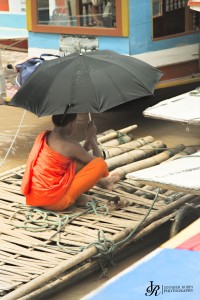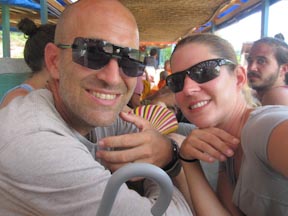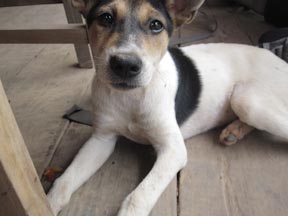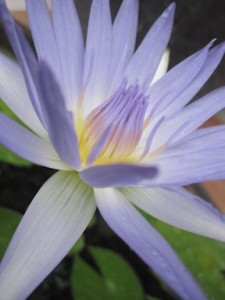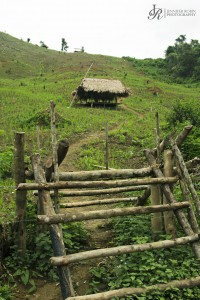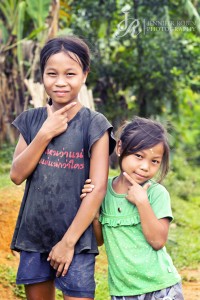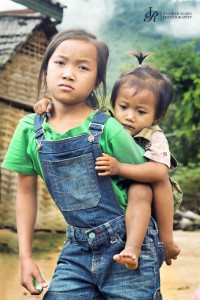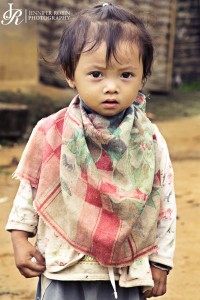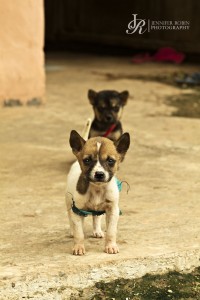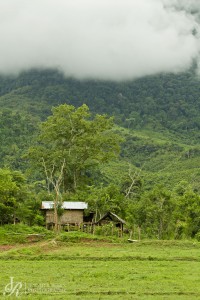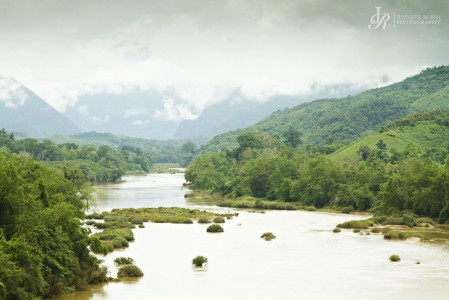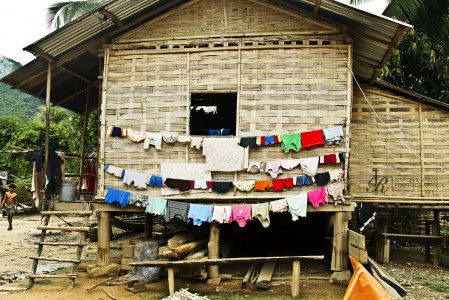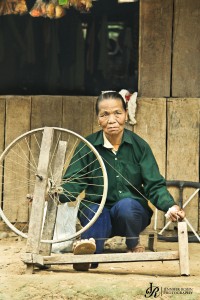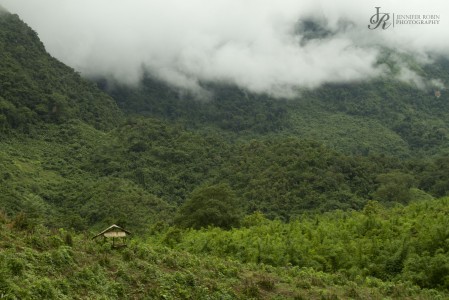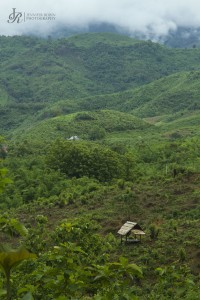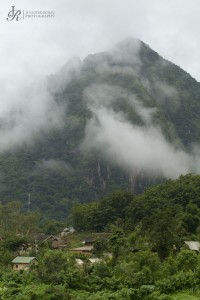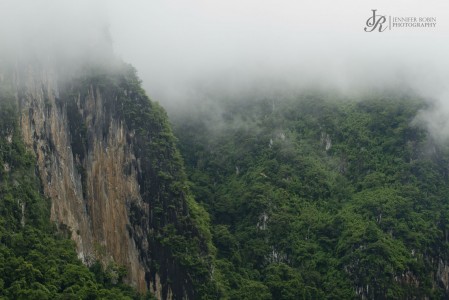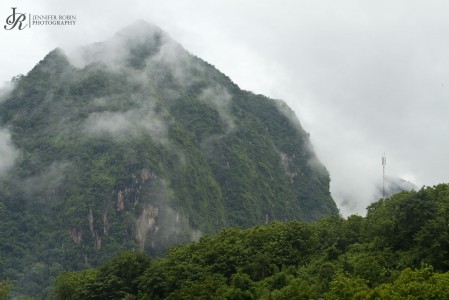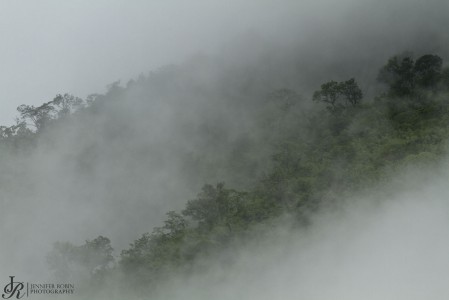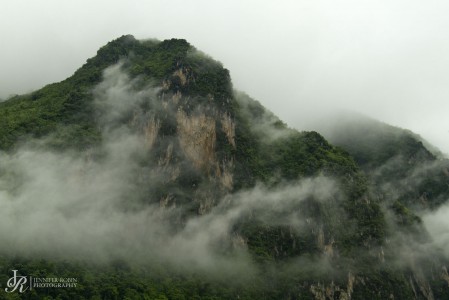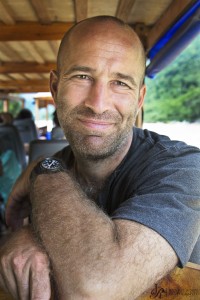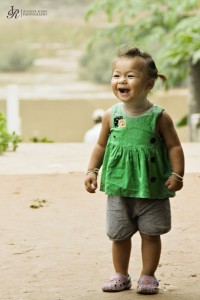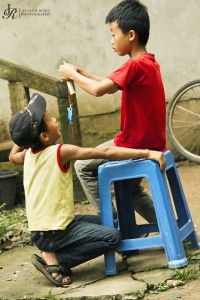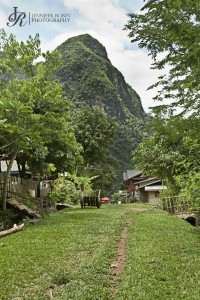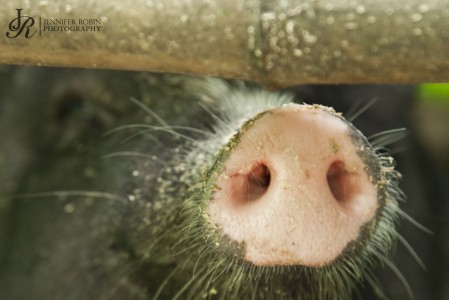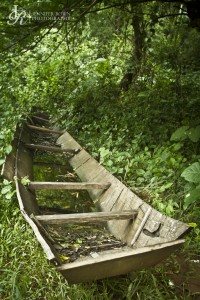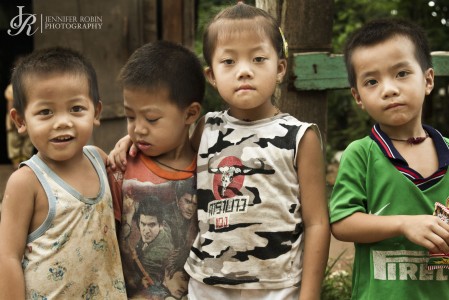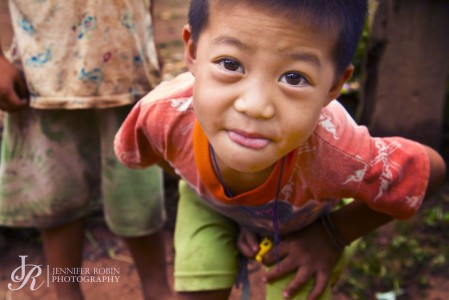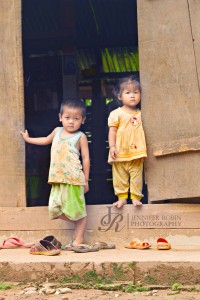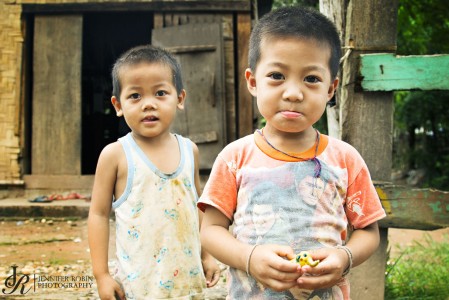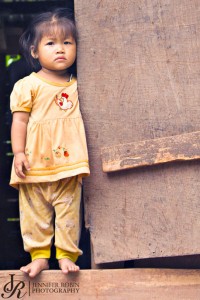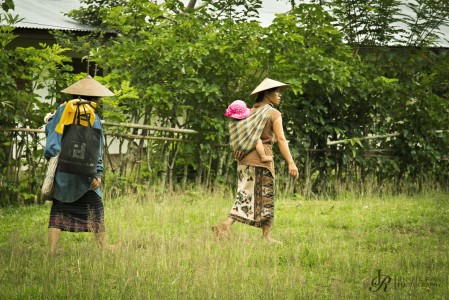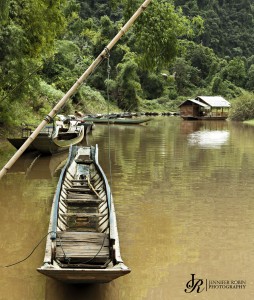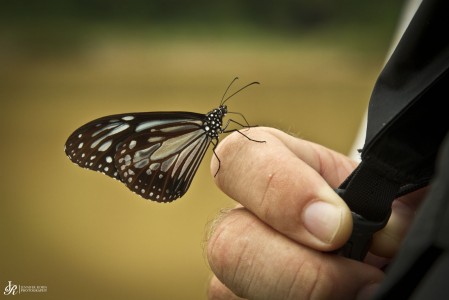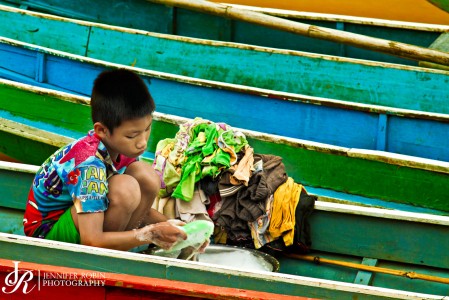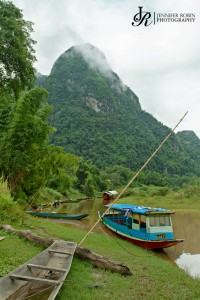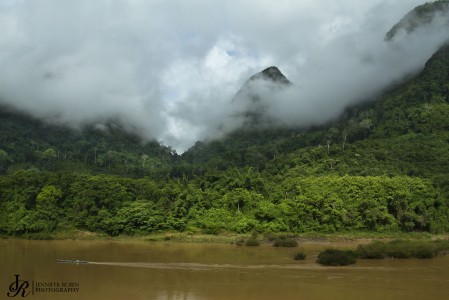The trip from Luang Prabang to Nong Khiaw started with a van that picked us up from our hotel, already loaded to the gills with other Western tourists and their baggage (mostly backpackers like us). The driver placed our packs on an already over-loaded roof, which should have buckled under the strain, and lightly tied them to other packs in the pile. I kept thinking that one sharp turn would spell catastrophe for our gear.
After stopping and stuffing yet another tourist into the van, we landed at the Luang Prabang northbound bus station, where all of us transferred to two other vans waiting to take us to Nong Khiaw. Yes, we were all going to Nong Khiaw.
The bus station was divided into two areas, separated by a road. On our side of the road was the more-expensive minibus terminal. Unlike Thailand, where Jen and I were invariably the only Western minibus passengers, at this bus stop all the minibus passengers were Westerners, headed to all parts of the country.
We handed our packs up to the driver, who was loading them onto the roof, and got into the minibus.
And this is where we made a tactical error: we sat in the back row.
In a normal van with a normal driver on normal roads, the back row would have been just fine; but in a jacked-up van with a Laotian driver on Laotian roads, it was not ideal positioning.
The van might as well have had no rear shocks. We were riding on the springs. Toss in the constant bumps and pot holes of the Laotian two-lane road that constitutes one of the country’s major roadways – and a driver that goes as fast as possible without regard for blind turns, other traffic, pedestrians, or road conditions – and what you get is a county carnival ride gone bad.
The ride was three hours of back-breaking bounces, and teeth-gritting acceleration around blind turns.
The folks closer to the front were at least spared the severe bouncing of the back of the van, so the lesson learned is to sit farther forward.
…and to take a sedative…
…and a preventive dose of Motrin…
At Nong Khiaw, we declined a taxi ride, put our packs on our backs, and began walking what we thought was about a hundred meters to the boat landing. This distance was based upon the map of the town in the Lonely Planet guide, and it turned out to be wrong by eight hundred meters or so. It was hot and more hot. We should have taken the taxi.
And that brings up some thoughts on Lonely Planet guide books. First off, their cartographer sucks. I can’t tell you how many times we’ve chosen to walk based upon the scale of on of the guide’s maps indicating a much lesser distance than proved to be reality.
Yeah, I’m a slow learner.
Beyond that, I have a love / hate thing with Lonely Planet. It’s a good starting point for getting into an area, in that it gives you some initial options for lodging and eating, and an idea of the sights to be seen; but it’s not comprehensive, and misses a lot of what’s available. Then again, how could it be? A comprehensive listing of all the hotels and guesthouses in Luang Prabang alone would be a volume unto itself. So, perhaps I am expecting too much.
My love / hate also extends to the impact Lonely Planet has upon destinations it covers, as it seems to me that it contributes to the conversion of virgin areas into defiled tourist spots. Think about it…if Lonely Planet says that XYZ village is a beautiful place, folks will read this and go there in greater numbers, which leads to guesthouse construction and pricier transportation and restaurant menus in English with Denny’s-style food pictures. So, while I feel a need for my Lonely Planet guides, I can’t escape the feeling that they are spoiling the things they praise; a sort of Greek tragedy in which writing that something is good assures it’s destruction.
You don’t have to look far to see the pervasiveness and impact of Lonely Planet. Tourists have their books in hand everywhere you look. Guesthouses, restaurants, and bars have signs bragging about their Lonely Planet reviews.
The result of all this is that I yell at my Lonely Planet and toss it into the trash, only to pull it out and put it back in my pack.
Back to Nong Khiaw…
After hiking to the boat ramp, we sorted out how to catch the next boat to Muang Ngoi, and settled down to lunch and a couple beers at a balcony restaurant overlooking the boat landing.
The boat was advertised for a 2:00pm departure, although I reckon that merely indicates when to start loading, as we didn’t leave until closer to 3:00pm.
 The boats that work the Nam Ou River between Nong Khiaw and Muang Ngoi are about 50 feet in length, and about 4-1/2 feet in width. They are long, narrow things with the engine in the back, the captain in the front, and the passengers and cargo in the space between. Most have two benches for seating – one along each gunwale – so that you sit facing inboard. I don’t know what these boats draw, but based upon how much they list when anyone moves, and how shallow the water appears that they negotiate, it can’t be much. Against the current, they seem to get about 15 knots.
The boats that work the Nam Ou River between Nong Khiaw and Muang Ngoi are about 50 feet in length, and about 4-1/2 feet in width. They are long, narrow things with the engine in the back, the captain in the front, and the passengers and cargo in the space between. Most have two benches for seating – one along each gunwale – so that you sit facing inboard. I don’t know what these boats draw, but based upon how much they list when anyone moves, and how shallow the water appears that they negotiate, it can’t be much. Against the current, they seem to get about 15 knots.
Into our boat was loaded just about everyone who had been in the minivan with us. This included three young Israelis, a young Brazilian couple, an older Japanese woman who was doing some solo travels, and the two of us. As to locals, there was the captain, his female first mate, two adult monks and three little monks, and three others. There was also a bit of cargo.
Fairly soon after getting underway, some problem developed in the engine area. The female first mate went to the stern, and Jen could see her trying to fix something while a stream of water was spraying her in the face and soaking her down. She started screaming something at the captain, who initially didn’t hear her over the engine noise. The boat was eventually beached, something repaired, and off we went without further issue.
Muang Ngoi is located about 30 kilometers upriver from Nong Khiaw, or about a 1-1/4 hour boat ride. It’s a winding river with alternating wide-and-calm  and narrow-fast-and-slightly-rapid-like spots. The terrain is mountainous. Along the way, you can get glimpses of the occasional small village. There are numerous other boats on the river and tied to it’s banks, including the larger ones like we were on and many smaller fishing boats.
and narrow-fast-and-slightly-rapid-like spots. The terrain is mountainous. Along the way, you can get glimpses of the occasional small village. There are numerous other boats on the river and tied to it’s banks, including the larger ones like we were on and many smaller fishing boats.
Like the slow boat to Luang Prabang, and the ordinary buses in Thailand, our boat stopped several times enroute to Muang Ngoi to drop passengers and cargo.
At Muang Ngoi, we were met by a handful of women touting their guesthouses. We had earlier decided upon a place called Veranda, based upon Lonely Planet, and pushed through and onward. Unfortunately, Veranda is no longer open. A local said it had been purchased by a European.
We looked at the bungalow of another guesthouse, but gave it a pass and walked back in the direction from which we had come to check out Lattanavongsa Guest House, which was number two on our list of possibles. This is where we settled (click here to read about it).
Muang Ngoi is a small, small village. If you toss in the chickens, ducks, geese, pigs, cows, dogs, and cats; you might break a thousand residents.
The mainstreet is a dirt strip paralleling the river, about the width of a single car lane, two or three hundred meters long, and leading no where. It just abruptly stops at both ends, servicing only the town itself. Concrete drainage ditches line both sides of mainstreet.
 Connecting to mainstreet are dirt (meaning mud this time of year) pathways that are the town’s equivalent of residential streets.
Connecting to mainstreet are dirt (meaning mud this time of year) pathways that are the town’s equivalent of residential streets.
Intermixed with the pathways are small streambeds, and other low drainage spots, that have collected years of the village’s debris.
The housing is mostly huts of the bamboo construction typical in these parts, with occasional concrete and cinder block construction thrown in.
As with virtually every village we’ve visited, the chickens and ducks and geese and dogs and cats are free to roam about. Unlike some villages, the pigs in Muang Ngoi are not so fortunate, instead being kept in small pens. Most of the cows were in a small field on the outskirts of town, the outskirts starting about 75 meters from mainstreet.
There are two monasteries in town. The main one is at the north end and is undergoing renovation. The other is near the south end and appears to be unused.
Scores of boats are tied to the riverbank.
Interwoven with all this is an active tourist trade. The strip between mainstreet and the river is almost exclusively dedicated to guesthouses and restaurants. There are additional guesthouses and restaurants on the opposite side of mainstreet as well. The Lonely Planet guide comments that during the peak season tourists can outnumber locals. Based upon the number of guesthouses, I don’t think this to be exaggeration.
Muang Ngoi strikes me as a traditional village overrun by tourism, and is still trying to hold onto something of what it had been before the first guesthouse  opened it’s doors. I suspect that there is an ongoing debate amongst the villagers about tourism versus keeping it local, much like has happened in the town of Kailua on the island of Oahu in Hawaii, where the keep-it-local camp opposed the vacation rental and tour bus camp. Like in Kailua, the tourism camp seems to have won in Muang Ngoi, damaging the original character of the place that had been its draw in the first place.
opened it’s doors. I suspect that there is an ongoing debate amongst the villagers about tourism versus keeping it local, much like has happened in the town of Kailua on the island of Oahu in Hawaii, where the keep-it-local camp opposed the vacation rental and tour bus camp. Like in Kailua, the tourism camp seems to have won in Muang Ngoi, damaging the original character of the place that had been its draw in the first place.
Like I said, the town still pushes forward with a village life that attempts to ignore the tourists. With the rising of the sun, the town gets busy, and things get noisy. At 4:00am, the monks at the monastery still bang the hell out of a wooden bell. Folks still head to the river to swim and bathe at dusk. Children still play on mainstreet. On Thursday morning, a full-fledged street market kicked off at 6:30am, with people arriving by boat from other villages up and down the river. (You can hear some of the sounds of the village by clicking here.)
So, Muang Ngoi is an interesting overlay of tourism onto village life, and would probably make a good study on the impacts of tourism in rural areas.
There are a few things to do around Muang Ngoi. You can hire a local boat for fishing or to head farther upriver to another village, or walk a kilometer and then climb a bit to see a couple of caves, or purchase one of the multi-day guided treks offered by the guesthouses. You can also park yourself on the balcony of your bungalow, drink beer, and work on that book you’ve always wanted to read.
We walked upriver to the caves. The caves (there are two entrances) are entered on the side of a steep hill, and you get there by walking up mud steps and then using makeshift bamboo ladders. There is no guide, but there is a shelter at the base of the hill where a 10,000 Kip per person fee is collected.
We didn’t find anything particularly remarkable about the caves. What we did find remarkable are the leeches that attacked our feet on the trails. By the time we got back to town, both of us had dealt with a score of them; and both of us had a decent puncture that bled for hours. The anticoagulant used by these little bastards is very effective and very long-lasting.
Before feeding, the leeches looked like thin little worms, about 3/4 of an inch long. After getting some time to turn you into breakfast, they get significantly larger. Jen says the one that really got busy with her ended up being 1-1/2 inch long and as thick as a drinking straw. I don’t know how big my nemesis got – he became a blood spot between my big toe and sandal strap before I got a good look at him.
Between the mosquitos, leeches, and other nasties, Jen and I are now experiencing phantom bites. I think we have PTSD.
By the way, Jen is nonplussed by the leeches. Cockroaches, however, freak her out. I find this curious – how someone could care less about something aggressively trying to eat them, but get animated by a bug that has never been known to physically attack a human being. As for me, I hate leeches, and now find myself inspecting my feet constantly whenever we are off hard surfaces.
More on Muang Ngoi…
They love some American pop song we didn’t recognize. It played over and over and over and over again during their early morning street market, being blasted throughout the town by a large speaker. There’s nothing like hearing, “When you touch my body…baby, touch my body…,” a thousand times over, to cheesy club music, on a loud and distorted sound system, at 6:30 in the morning.
 After two nights, we left Muang Ngoi, and headed back to Nong Khiaw. Boat is the only option to get to and from Muang Ngoi, and there were so many Western tourists leaving (over 30) that two boats were needed. We got on the second boat, which had the luxury of forward-facing seats, two abreast; some of which were bucket car seats. We were last in line, and the captain moved the boat before Jen and I could board so that the cargo area was at the landing and the seating area out of reach. It was his way of drafting me to help with loading the baggage.
After two nights, we left Muang Ngoi, and headed back to Nong Khiaw. Boat is the only option to get to and from Muang Ngoi, and there were so many Western tourists leaving (over 30) that two boats were needed. We got on the second boat, which had the luxury of forward-facing seats, two abreast; some of which were bucket car seats. We were last in line, and the captain moved the boat before Jen and I could board so that the cargo area was at the landing and the seating area out of reach. It was his way of drafting me to help with loading the baggage.
The ride back was uneventful and pleasant.
Back at Nong Khiaw, we walked the half-a-mile or so to the bus station to get a ride east to Vieng Thong. This proved not so easy. The ticket agent quoted me a price of 110,000 Kip per person for a distance that looked on the map to be no farther than the ride from Luang Prabang, and for which we had spent 80,000 Kip each. He also said the distance was 270 kilometers and would take eight to nine hours, neither of which matched the map or what I had read (reference material said it was a three hour ride). I started thinking he was either bullshitting me or we were talking about two different destinations. So, I pulled out the map to make sure we were talking the same location, and that’s when he just kinda shut down on me, saying “I don’t know” repeatedly. Realize this was a guy speaking decent English and claiming to know quite a bit just a few minutes earlier.
And that’s when I said “Fuck it,” threw my pack on my back, and drug Jen the half-mile back to the center of town, and from there across the bridge, and onward to the Nong Kiau River Side hotel; where we got a bungalow (click here to read about the hotel).
The ticket guy at the bus station had pissed me off, and I figured it was time to spend a night and inquire with locals about transportation options for heading farther east.
Well, there aren’t many.
There’s the minibus that we had arrived on, which may or may not operate on any given day, and may or may not continue past Nong Khiaw. You have to call the morning of intended departure to see if it’s running.
There’s apparently an evening bus heading east from Nong Khiaw, which might pass through at anytime in a five hour window (just plant yourself at the side of the road, and wait and see), and that would put us into Vieng Thong at zero-dark-thirty.
That’s about it. The Lonely Planet guide mentions pickup-buses making several transits a day between Nong Khiaw and Vieng Thong to the east, but locals dont know what they are talking about. As the Western guy running things at the Nong Kiau River Side put it, heading east of Nong Khiaw is an adventure.
We have now been at Nong Khiaw for two nights, and are staying a third. Last night, we blindfolded Jen and had her throw a wad of gum at a map of Laos  stuck to the wall by safety pins. After five throws, she managed to hit inside the borders of The country, at a spot in the central districts. That’s where we intend to end up before our visas expire.
stuck to the wall by safety pins. After five throws, she managed to hit inside the borders of The country, at a spot in the central districts. That’s where we intend to end up before our visas expire.
For now, we have the following “plan:” continue east when we can get a ride, eventually looping south to the Plain of Jars, and from there working south to central Laos and the gum spot.
In addition to throwing gum at maps, we have done a bit of exploring around Nong Khiaw. We walked a mud road to visit two small villages to the north, about a 6-1/2 mile round trip. For much of it, we slogged along with ten-pound mud sandals (the mud was very sticky clay), and managed to pick up a few more leeches. The first village was very small and very friendly; the second one was bigger and more orderly, but had obviously received some tourists in the past, as evidenced by the not-as-friendly reception and the efforts to sell us boat rides. Overall, it was a fun day.
Nong Khiaw itself is in a picturesque setting, with a river running through it, surrounding mountains, and a cliff face that guards the northern river approach. The mountains are misted in the mornings. It rains heavily for one hour periods, one or two times a day. It seems like there’s always some sort of precipitation in the air, if only a mist, or a drop or two threatening a deluge. As I write, there’s a full-blown downpour.
We have found a decent restaurant here, the Vongmany Restaurant (click here).
Overall, Nong Khiaw doesn’t suck as a place to stay. Just the bus ticket guy sucks.
By the way, it’s only 170 kilometers to Vieng Thong, and it takes about four hours – not eight or nine.
